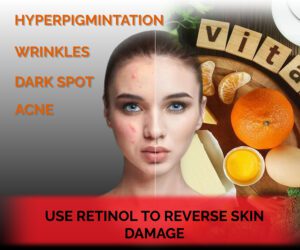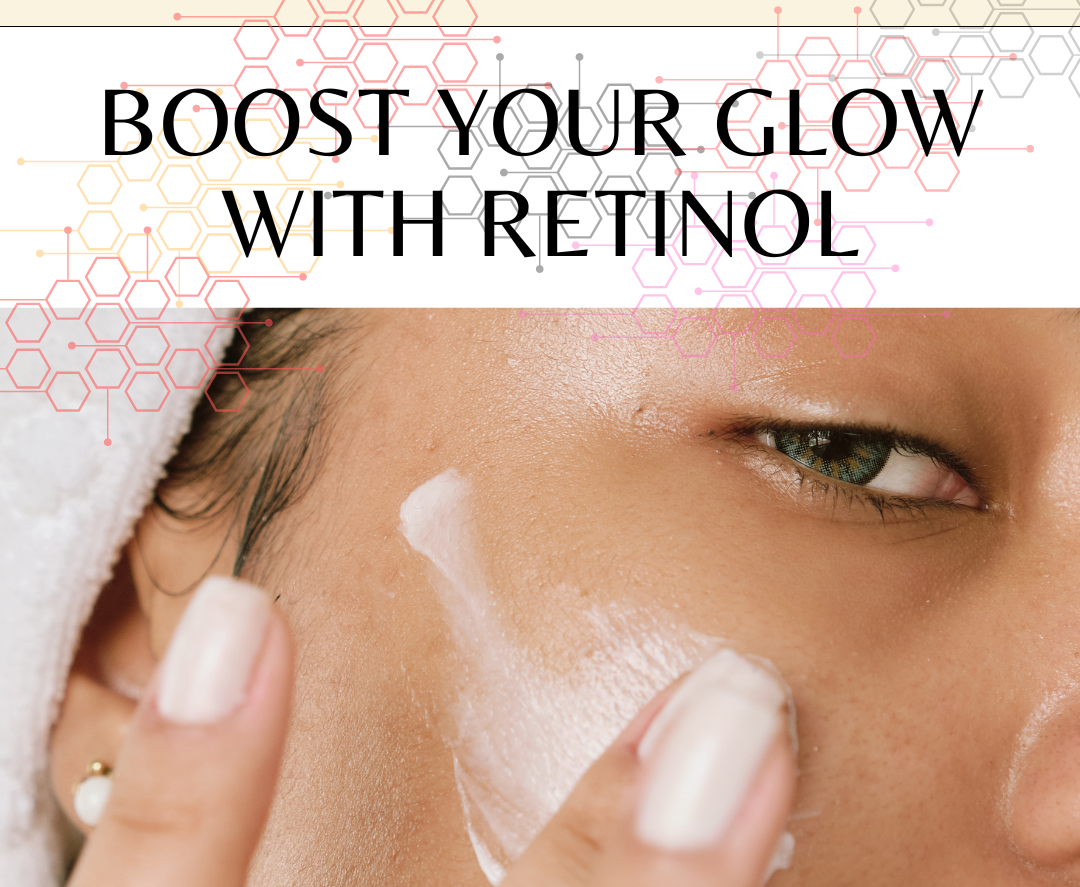Free radicals are unstable chemicals that can damage skin cells and make your skin age faster. Retinol helps by catching and getting rid of these harmful molecules. This protects your skin from damage caused by things like the sun and pollution.
Two things frequently contribute to skin ageing: internal and exterior influences. Every year, 1% less skin elastin and collagen are synthesized, which leads to a disorder of the connective tissue. Because of this loss of collagen and elastin, the skin’s dermis layer wrinkles. Our faces undergo various changes as we age, such as the appearance of wrinkles, lines from laughter, and forehead furrows. We cannot discount the importance of collagen in our bodies if we want to preserve our skin’s elasticity, youthful texture, and complexion. As we age, wrinkles and less supple skin result from our bodies producing less collagen. natural exfoliation has diminished. Our skin’s capacity to release dead cells diminishes with age, leading to the build-up of dry, flaky skin. Did you know there is a very simple solution to combat these problems? The solution is a derivative of Vitamin A known as Retinol.
What is Retinol cream or serum?
Retinol, a form of vitamin A, is an ingredient added to skin creams, lotions and serums. It has antiaging effects and can help clear acne. Retinol is a topical treatment, meaning you apply it on top of your skin. Retinol comes in many forms, including creams, gels, lotions, ointments and serum. Sometimes it may also be used in cosmetic products.
Benefits of Retinol cream/serum
Fact #1: Retinol supports healthy cell turnover.
Every 28 days, until you’re in your early 30s, your cells regenerate to expose a new layer of unblemished, flawless skin. But after you reach your mid-30s, your cell renewal slows down and happens every 50, 60, or 70 days. The reason your face seems dry, lifeless, and wrinkled is because of the reduced rate of cell renewal. Your skin absorbs retinol more quickly and produces smoother, younger-looking skin as a result of accelerating cell turnover. Keep in mind that you might not notice effects right away; photodamage, acne, and fine wrinkles will lessen after three to six months of regular night time application.
Fact #2: Retinol cream/serum for acne
One common skin condition we all go through is acne. You may get blackheads, whiteheads, or other types of pimples when dead skin cells and/or oils clog your pores. Retinol treats acne by keeping pores from getting clogged. During the first few months of treatment, you can still have pimples; in fact, your skin might look worse (this is frequently referred to as the retinol purge). But you’ll notice clearer skin if you persevere.
Fact #3: Retinol cream/serum for acne scars
Scars from acne are the result of inflammation and damage. These weeks-long, pink, red, or dark spots on your skin may develop as your acne heals. Furthermore, popping or picking at zits inflicts extra damage to the skin and may result in long-lasting scars. Topical retinol treatments can help stop more breakouts and lessen the swelling and inflammation that accompany them. On the other hand, sunken or elevated severe acne scars are not always responsive to topical retinol treatment.

Retinol Cream
Fact #4: Retinol for dark spots
Sun damage to your skin can lead to the development of dark spots, often known as hyperpigmentation. The accumulation of melanin, which gives your skin its colour, is what causes light to dark brown spots on your hands, arms, neck, or face (pigment). These spots, which are also known as sun spots, age spots, and liver spots, are painless, but if you’re self-conscious about their appearance, there are procedures and topical treatments that could assist. Although it takes months and can irritate your skin, some people find that topical retinol lightens their skin spots.
Fact #5: Retinol for large pores
A pore is an opening at the surface of your skin that allows body hair and oils to pass through. When these pores become clogged with dead skin cells or oil, your pores become bigger and more noticeable. Topical retinol treats large pores by increasing skin cell turnover — which makes your skin thicker — and preventing the development of clogged pores.
Fact #6: Retinol for wrinkles
There are several things that might lead to wrinkles in your skin. Your skin cells divide more slowly as you get older. Your skin’s dermis, or middle layer, starts to weaken, losing its ability to hold onto moisture and producing fewer collagen and elastin. By decreasing the rate at which collagen breaks down and increasing the elasticity of your skin, topical tretinoin and tazarotene can help minimise the appearance of fine lines and wrinkles. Typically, using topical retinol for several months is necessary to observe any change.
How do you use retinol cream/serum?
Before you use a retinol product(cream/serum) for the first time, try a patch test to see if you have any negative reactions. If, after a couple of days, your skin patch isn’t very red or itchy, you can add retinol to your skincare routine at bedtime.
Apply retinol cream or serum according to the directions on the package or as advised by your healthcare provider. These are the general actions you take:
- After using a mild cleanser, pat dry your skin. Avoid cleaning your skin with retinol products.
- Spread retinol thinly over your face, taking care to avoid getting it in your eyes, nose, or mouth. A dose the size of a pea is what you should use.
- Apply retinol only once every other day for the first few weeks of treatment.
- Apply a noncomedogenic face moisturiser to seal in your pores.
Possible side effects of Retinol cream/serum
While retinol has its uses, it has some side effects as well such as:
- Dry, irritated skin.
- Itching or burning.
- Redness, peeling, flaky or scaly skin.
- Sunburns
These side effects should gradually go away as your skin gets used to the new treatment.
How can you manage the side effects of retinol?
Making small adjustments to your skincare routine may help reduce the redness and irritation that can come with using retinol. It might help to:
- Use a single retinol product at a time.
- Instead of using retinol daily, use it every other day.
- After cleansing your skin, wait half an hour before using a retinol product.
- If you have damaged skin, sunburned skin, or other skin irritations, stay away from retinol products.
- Wear hats and clothes that shield you from the sun, along with SPF 30 to minimise your exposure to the sun.
| If you use retinol, you’ll sunburn more easily, which can damage your skin. Using high doses of retinol may also be associated with the development of skin cancer. Be sure to wear sunscreen and avoid direct sunlight (with clothing and hats) while you use retinol products. |
It’s common to detect changes in our skin with age. Everybody eventually develops wrinkles and pimples in their lives. If, however, you are unhappy with the way your skin feels or looks, there are many different treatments available to help. One chemical that can aid in clearing and plumping your skin is retinol. Try not to give up on retinol just because it takes a few weeks to show benefits. Your skin may appear worse before it gets better. Increase your retinol usage gradually, starting out softly.
Chek out:








0 Comments